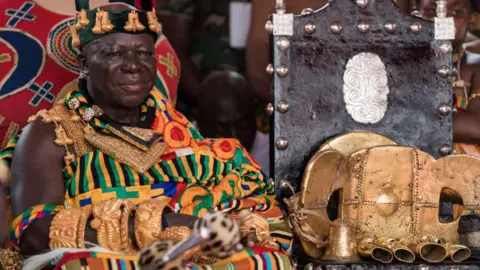The Asante Kingdom has welcomed the historic return of 130 treasured artefacts—gold regalia, bronze ornaments, and ceremonial drums—that once adorned its royal courts and symbolized centuries of cultural prestige and spiritual authority.
The items, some of which were looted during the 19th-century Anglo-Asante wars and others acquired later on open markets, were officially handed over to Asantehene Otumfuo Osei Tutu II in a moving ceremony at the Manhyia Palace in Kumasi on Sunday.
The artifacts, dating back to the 1870s, illuminate the deep connection between gold, royalty, and sacred tradition in Asante civilization—a culture where craftsmanship, ritual, and power were inseparable.
A Gesture of Respect and Reconciliation
The return was made possible through two major donations: 25 pieces from British art historian Hermione Waterfield and 105 others from AngloGold Ashanti, a mining company with operations in Ghana and South Africa.
Speaking at the ceremony, representatives from AngloGold Ashanti described the gesture as an act of “cultural respect and reconciliation,” acknowledging the importance of returning objects that embody the spirit and heritage of the Asante people.
Relations between AngloGold Ashanti and communities in the Ashanti Region have at times been strained, with local leaders accusing the company of reaping vast profits from the region’s minerals without adequate development benefits.
But Otumfuo Osei Tutu II said the voluntary return of the artifacts marked a “renewal of goodwill and respect for the legacy of the Asante Kingdom.”
“This act recognizes not only the historic value of these treasures but also their soul—the story of our people and our enduring identity,” he said.
A Lifetime of Advocacy
Hermione Waterfield, a pioneering figure in African art scholarship, helped shape Western understanding of indigenous art forms. As a curator at Christie’s in London, she established one of the first departments dedicated to African tribal art in the 1970s.
Read Also: Changan taps Yango to boost fleet quality in Africa
Her donation included a wooden drum looted during the 1900 siege of Kumasi by British troops—a relic of one of the most painful episodes in Asante history.
Ivor Agyeman-Duah, Director of the Manhyia Palace Museum, described the return as “a deeply symbolic act that goes beyond restitution—it is a reconnection of history, art, and identity.”
Restitution Movement Gathers Momentum
The Asante artefacts’ return adds to growing global efforts to repatriate African cultural treasures seized during the colonial era.
Last year, the British Museum and the Victoria & Albert Museum loaned 32 looted artifacts to the Manhyia Palace Museum under a three-year agreement.
Germany has also returned dozens of Benin bronzes to Nigeria since 2022, marking a broader reckoning with Europe’s colonial past.
For the Asante Kingdom, Sunday’s ceremony was not only a return of priceless art—it was a restoration of memory and dignity.
“These treasures are home again,” said Agyeman-Duah. “They tell our story—not from a foreign museum, but from our own soil, to our own people.”
SOURCE: BBCNEWS




























